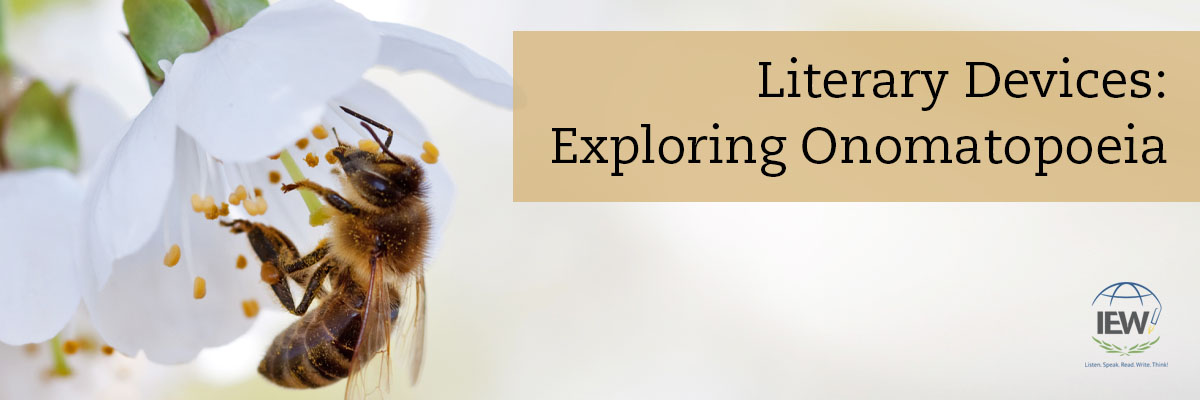Among the tools available for writers is a broad array of literary devices, including alliteration, foreshadowing, and onomatopoeia, just to name a few. In today’s blog post we would like to highlight one of these devices: onomatopoeia. The word onomatopoeia is a blend of two Greek words: onoma, which means “name” and poiein, which means “to compose” or “to make.” Interestingly, the word poet comes from this same root.
Onomatopoeia is the use of words that mimic the sounds those words refer to. Here are a few examples:
-
The bee buzzed near the flowers.
-
The child splashed in the puddle.
-
The dog growled at the stranger.
-
The boy gulped his milk.
-
“Eek!” cried the woman when she spied the spider.
-
He jingled his keys into the lock.
While some essay types tend to avoid onomatopoeia, it is more frequently found in descriptive essays, fiction, and poetry. Onomatopoeia is regularly encountered in children’s literature. When writers include onomatopoeia in their writing, it casts a more vivid picture because it helps the readers to “hear” the action in their minds. It is a great way to stimulate the senses to help bring a written passage to life.
There are some lovely examples of onomatopoeia sprinkled across literature and poetry. Here are a few pieces you may enjoy. The examples of onomatopoeia are in italics:
He went back towards the toolshed, but suddenly, quite close to him, he heard the noise of a hoe—scr-r-ritch, scratch, scratch, scritch. Peter scuttered underneath the bushes.– from The Tale of Peter Rabbit by Beatrix Potter
Foot it featly here and there,
And sweet sprites bear
The burden. Hark, hark!
Bow-wow.
The watchdogs bark.
Bow-wow.
Hark, hark! I hear
The strain of strutting chanticleer
Cry cock-a-diddle-dow.
– from Act 1, Scene 2 of The Tempest by William Shakespeare
He saw nothing and heard nothing but he could feel his heart pounding and then he heard the clack of stone on stone and the leaping, dropping clicks of a small rock falling. – from Chapter 23 of For Whom the Bell Tolls by Ernest Hemingway
One unique example of onomatopoeia appears in Lewis Carroll’s nonsensical poem “Jabberwocky.” Carroll crafted it using lots of invented words, but by the manner in which he presents them, the reader is able to imagine the action even without exactly knowing the meaning of the words. This is because Carroll wrote the poem using regular syntax and grammar, which makes the poem feel natural and accessible. This piece, by the way, is included in Linguistic Development through Poetry Memorization. Here it is in its entirety for your reading enjoyment:
Jabberwocky
by Lewis Carroll
’Twas brillig, and the slithy toves
Did gyre and gimble in the wabe:
All mimsy were the borogoves,
And the mome raths outgrabe.
“Beware the Jabberwock, my son!
The jaws that bite, the claws that catch!
Beware the Jubjub bird, and shun
The frumious Bandersnatch!”
He took his vorpal sword in hand;
Long time the manxome foe he sought—
So rested he by the Tumtum tree
And stood awhile in thought.
And, as in uffish thought he stood,
The Jabberwock, with eyes of flame,
Came whiffling through the tulgey wood,
And burbled as it came!
One, two! One, two! And through and through
The vorpal blade went snicker-snack!
He left it dead, and with its head
He went galumphing back.
“And hast thou slain the Jabberwock?
Come to my arms, my beamish boy!
O frabjous day! Callooh! Callay!”
He chortled in his joy.
’Twas brillig, and the slithy toves
Did gyre and gimble in the wabe:
All mimsy were the borogoves,
And the mome raths outgrabe.
This poem presents marvelous examples of onomatopoeia. “He went galumphing back” creates an image in readers’ minds even though there is no dictionary definition of galumph. The same stands for the jubilant “Callooh! Callay!” that’s “chortled” after the Jabberwock is destroyed. To hear the full poem and all of its ingenious examples of onomatopoeia, listen to Andrew Pudewa recite it at this link.
Onomatopoeia is a delight to teach to students. To help your students create a list of these words, consult IEW’s downloadable PDF Practical Printables: Onomatopoeia for suggestions. Then spend some time crafting sentences together. Soon, you will have several possibilities that students can leverage in their writing assignments
|
Jennifer Mauser has always loved reading and writing and received a B.A. in English from the University of Kansas in 1991. Once she and her husband had children, they decided to homeschool, and she put all her training to use in the home. In addition to homeschooling her children, Jennifer teaches IEW classes out of her home, coaches budding writers via email, and tutors students who struggle with dyslexia. |


